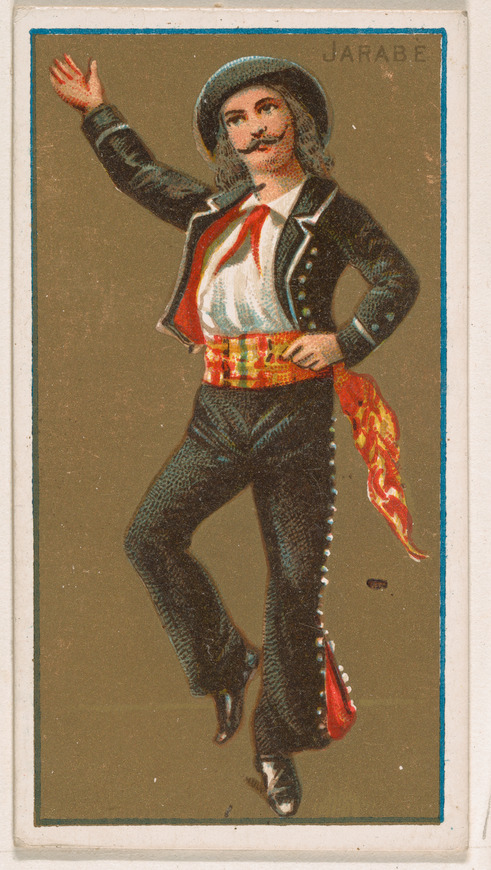jarabe on:
[Wikipedia]
[Google]
[Amazon]
The jarabe is one of the most traditional song forms of the  While most jarabes from Jalisco are not sung, those from Zacatecas do have verses. Many of these traditional jarabes from Zacatecas are being revived by the traditional group ''Los Jaraberos de Nochistlán''.
Jarabe verses were a vehicle of popular resistance during the
While most jarabes from Jalisco are not sung, those from Zacatecas do have verses. Many of these traditional jarabes from Zacatecas are being revived by the traditional group ''Los Jaraberos de Nochistlán''.
Jarabe verses were a vehicle of popular resistance during the
mariachi
Mariachi (, , ) is a genre of regional Mexican music that dates back to at least the 18th century, evolving over time in the countryside of various regions of western Mexico. The usual mariachi group today consists of as many as eight violins, t ...
genre. In the Spanish language
Spanish ( or , Castilian) is a Romance languages, Romance language of the Indo-European language family that evolved from colloquial Latin spoken on the Iberian peninsula. Today, it is a world language, global language with more than 500 millio ...
, ''jarabe'' literally means ''syrup'', which probably refers to the mixture of meters within one ''jarabe'' (compare ''salsa
Salsa most often refers to:
* Salsa (Mexican cuisine), a variety of sauces used as condiments
* Salsa music, a popular style of Latin American music
* Salsa (dance), a Latin dance associated with Salsa music
Salsa or SALSA may also refer to:
A ...
'').
Typically, a jarabe will go from a to others sections with , , return to and end in another meter. The 6/8 rhythmic pattern is a constant pattern with no ''contratiempos'' as in the ''son jaliscience Son jalisciense is a variety of Mexican son music from which modern mariachi music is derived. This ''son'' also relied on the same basic instruments, rhythms and melodies as the sones of Veracruz and other locations, using the same string instrume ...
''. Although today the ''jarabes'' are instrumental songs only, the ''jarabes'' originated as a medley of favorite regional ''sones'' and ''canciones''. The regional nature of the ''jarabes'' are often visible in their name, e.g. ''Jarabe tapatío
''Jarabe tapatío'', often referred to as the Mexican hat dance, is the national dance of Mexico. It originated as a courtship dance in Guadalajara, Jalisco, during the 19th century, although its elements can be traced back to the Spanish ''zambr ...
'' (''Tapatío
is a Mexican Spanish colloquial term for someone from downtown in the state of , Mexico's second-largest city. It is also used as an adjective for anything associated with or the highlands of .Prieto, Jorge Mejía (1985''Asi Habla El Mexicano' ...
'' is something or someone from the city of Guadalajara, Jalisco
Guadalajara ( , ) is a metropolis in western Mexico and the capital of the state of Jalisco. According to the 2020 census, the city has a population of 1,385,629 people, making it the 7th largest city by population in Mexico, while the Guadalaj ...
). The ''jarabe'' is traditionally performed with dancers, and in its traditional form constituted a highly improvised choreographic tradition.
 While most jarabes from Jalisco are not sung, those from Zacatecas do have verses. Many of these traditional jarabes from Zacatecas are being revived by the traditional group ''Los Jaraberos de Nochistlán''.
Jarabe verses were a vehicle of popular resistance during the
While most jarabes from Jalisco are not sung, those from Zacatecas do have verses. Many of these traditional jarabes from Zacatecas are being revived by the traditional group ''Los Jaraberos de Nochistlán''.
Jarabe verses were a vehicle of popular resistance during the Mexican Revolution
The Mexican Revolution ( es, Revolución Mexicana) was an extended sequence of armed regional conflicts in Mexico from approximately 1910 to 1920. It has been called "the defining event of modern Mexican history". It resulted in the destruction ...
. While church and state decried them as immoral and subversive, and the accompanying dance as lascivious, the people felt the ''jarabe'' represented them and their political aspirations.
References
{{Reflist Mexican styles of music Mexican music Mariachi